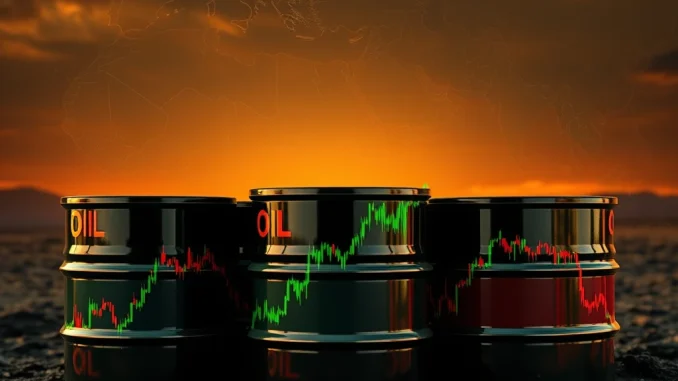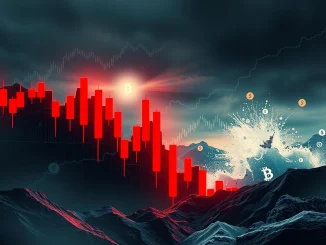
Hey crypto enthusiasts! While you’re focused on Bitcoin charts and altcoin movements, major shifts in the global economy can sometimes create unexpected waves. One such event just happened: a significant jump in Oil Prices. This might seem unrelated, but understanding these global economic tremors is key to navigating the broader investment landscape, including the volatile Crypto Market.
Why the Spike in Oil Prices Matters
Recently, we saw a dramatic increase in Oil Prices. Both Brent crude and West Texas Intermediate (WTI) futures contracts jumped by more than 10% in a short period. This kind of rapid movement isn’t just a number on a screen; it has real-world consequences.
Here’s why this jump is significant:
- Inflationary Pressure: Higher energy costs feed directly into inflation. Transportation becomes more expensive, manufacturing costs rise, and this eventually impacts the price of goods and services we all buy.
- Consumer Spending: When people pay more at the pump, they have less money for other things. This can slow down economic growth.
- Corporate Profits: Businesses that rely heavily on energy inputs see their costs increase, potentially squeezing profit margins.
This wasn’t a gradual climb; it was a sudden spike triggered by specific events.
Unpacking the Geopolitical Events Behind the Jump
The primary catalyst for this recent spike in Oil Prices was a direct result of heightened tensions in the Middle East. Reports indicated an Israeli airstrike in Iran, escalating an already fragile situation between the two nations.
Geopolitics has always played a crucial role in the energy markets, particularly oil. The Middle East is a major oil-producing region, and any conflict or instability there raises concerns about potential disruptions to supply lines.
Think of it this way:
- Increased tension or conflict in a major oil-producing area.
- Market participants (traders, analysts) anticipate potential supply disruptions.
- Demand remains constant or grows, while potential supply shrinks.
- This supply/demand imbalance drives prices up.
This isn’t the first time Geopolitical Events have sent shockwaves through the oil market, and it likely won’t be the last.
Understanding Market Volatility in Response
The immediate 10%+ jump in oil futures is a clear example of significant Market Volatility. Markets hate uncertainty, and geopolitical conflicts are inherently uncertain. Traders react quickly to price in the potential risks.
This volatility isn’t confined to just the oil market. When a major global commodity like oil experiences such a sharp move due to geopolitical factors, it tends to ripple across other asset classes.
We often see:
- Increased demand for safe-haven assets like gold or certain government bonds.
- Sell-offs in riskier assets like stocks.
- Heightened caution across the board as investors assess the potential for wider conflict or economic fallout.
Navigating periods of high Market Volatility requires careful analysis and often a defensive posture from investors.
The Broader Impact on the Global Economy
A sustained period of high Oil Prices can have a tangible impact on the Global Economy. For countries that are net oil importers, higher prices mean a larger portion of their national income goes towards buying energy, impacting trade balances and potentially weakening their currency.
Central banks also watch energy prices closely because of their link to inflation. Persistent inflation pressure from energy can influence monetary policy decisions, such as interest rate hikes. Higher interest rates can, in turn, affect borrowing costs for businesses and consumers, potentially slowing economic activity.
Consider these points:
| Impact Area | Effect of High Oil Prices |
|---|---|
| Inflation | Increases costs across sectors |
| Economic Growth | Can slow down as consumer spending drops |
| Monetary Policy | May prompt central banks to raise rates |
| Trade Balances | Worsens for net oil importers |
The health of the Global Economy is interconnected, and oil plays a fundamental role.
Potential Ripple Effects on the Crypto Market
Now, how does a jump in oil prices, driven by Geopolitical Events and creating Market Volatility in the Global Economy, potentially affect the Crypto Market? The link isn’t direct, but it exists through macroeconomic channels.
Here’s how it might play out:
- Inflation Hedge Narrative: Some investors view Bitcoin as a potential hedge against inflation. If rising oil prices contribute to higher inflation globally, this narrative could gain traction, potentially increasing interest in Bitcoin.
- Risk-On/Risk-Off Sentiment: Crypto assets, particularly altcoins, are often considered risk-on investments. When geopolitical tensions rise and global markets become volatile, investors may move away from riskier assets towards perceived safer options. This could lead to selling pressure in the crypto market.
- Liquidity: Major market shifts can impact overall market liquidity. If traditional markets face significant stress, it could affect the capital available for investment in riskier assets like crypto.
- Policy Response: As mentioned, central banks might react to inflation caused by energy prices. Monetary tightening (like rate hikes) can negatively impact growth assets, including crypto.
While crypto has its own unique drivers, it doesn’t exist in a vacuum. It is increasingly influenced by global macroeconomic trends and investor sentiment shaped by events like significant moves in Oil Prices.
Understanding these broader market dynamics helps you anticipate potential shifts and manage your crypto portfolio more effectively. It highlights the importance of staying informed not just about blockchain tech, but also about the wider world.
In Conclusion: Staying Alert in Interconnected Markets
The recent sharp rise in Oil Prices following escalating Geopolitical Events in the Middle East is a stark reminder of how quickly Market Volatility can emerge. This event has immediate consequences for the Global Economy, primarily through inflationary pressures and potential slowdowns in growth.
For those invested in the Crypto Market, this serves as a signal to pay attention to external factors. While not a direct cause-and-effect, the macroeconomic environment shaped by events like oil price shocks can certainly influence investor behavior and market sentiment towards digital assets. Staying informed about these global dynamics is crucial for making informed decisions in the interconnected world of finance.



